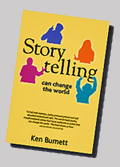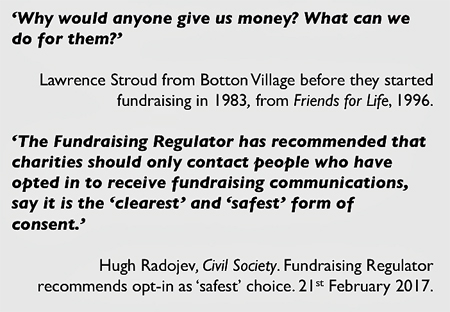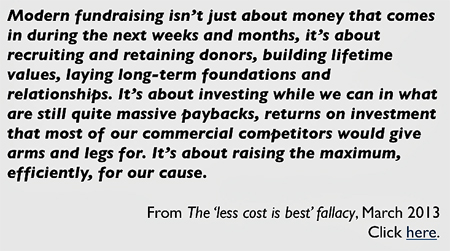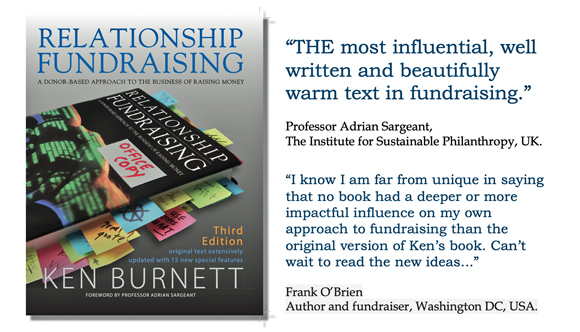|
Blog 9th April 2017 Our sector has failed to make self-regulation work and now, unless we take concerted action, those who depend upon charities and their services may be about to pay the heaviest possible price for that failure. There is a seductive logic Many people happily support a lot of charities with a small regular gift that they soon forget and scarcely miss. How many causes will the average donor be willing to opt in to? Many fewer than he or she might willingly support. ...fundraisers won’t be able to contact donors who have not opted in to receive communications informing them about what the charity has done with their gifts. Who does that help?
|
I’m no enthusiast for small print or screeds of regulations.
I’ve always dreaded imposition of ‘opt in’ from those on the outside who don’t get fundraising and fail to grasp why it’s so fundamental to the national treasure that is our voluntary sector, with the massive social good our charities make possible. The threat of opt in has been around for decades. Effective self-regulation might have kept it at bay but many believe our sector has failed to make self-regulation work and now, unless we take concerted action, those who depend upon charities and their services may be about to pay the heaviest possible price for that failure. There is a seductive logic to opt in, which quickly falls apart if you understand fundraising and how donors, like other people, react to requests to either opt in to or opt out of anything. Fine in theory, offers to opt in to marginally important activities won’t work in practice because of simple inertia – the most consistent human response to just about anything. Of course fundraisers don’t want to send material to people who have no possible interest in receiving it. It’s a waste of time, money and goodwill. But with charity donors there’s a massive grey area because so many supporters are happy to sustain a basket of causes they get only intangible benefit from and rarely give much thought to. Fundraisers don’t want to lose contact with these important past donors who have not in any way indicated that they don’t want to be communicated with. More than 30 years ago, for Camphill Village Trust, we developed a system that works much better (see below), that gives donors practical control and the chance to opt out at any time while allowing dormant supporters to stay connected until they’re ready to give again, or not, as they wish. When it comes to regular giving, many people happily support a lot of charities with a small regular gift that they soon forget and scarcely miss. How many causes will the average donor be willing to opt in to? Many fewer than he or she might willingly support, I fear. If a model based on, say, 10 per cent annual attrition suddenly has to replace, say, 30 per cent of donors or more, it will quickly become unviable and atrophy. Seriously, do the sums. Some charities have estimated that, if obliged to go the opt-in route, they will lose 50 to 85 percent of their donors. New donor acquisition is so expensive now. If retention (by providing a better donor experience) should be the new acquisition, where’s the sense in opt-in? What’s more, many fundraisers assume that, under opt in, regular giving will continue as before because direct debit payments can be expected to arrive automatically. But fundraisers won’t be able to contact donors who have not opted in to receive communications informing them about what the charity has done with their gifts. Who does that help? As many donors happily let their direct debits run indefinitely, most who don’t hear from the charity will assume they’re either ungrateful or can’t be bothered to acknowledge their gifts, or they’ll simply forget about their giving entirely. How can this be in the interests of a good donor experience? Plus, as ‘silent’ electronic renewal seems to fly directly in the face of the new regulations it’s not clear to me how those donors who simply give electronically automatically will be treated in the future. If regular direct debit donors have to opt in too, the current funding model for many charities seems perilously vulnerable. What should we do about it? Meanwhile at the suggestion of the ICO’s group manager of corporate governance I have added my comments to their consultation process. These are predicated on concern about a specific point in both the ICO’s and the Fundraising Regulator’s guidance which states that opting in ‘is the ‘clearest’ and ‘safest’ form of consent’. Prior to this we had hoped that charities might avoid the catastrophe that will be ‘opt in’ by following the ‘legitimate interest’ route. This concern is real because many trustee boards will now be telling their management teams, ‘Ah, we’d better now follow the advice and go for the safest, clearest route’.
3. Do you have any examples of consent in practice, good or bad, that you think would be useful to include in the guidance? While not quite ‘consent in practice’ as you have defined it, the following is a 30-year prime example of getting it right for donors and for the cause they support. The Camphill Village Trust’s system for offering donors effective and practical control of what they receive (known as continuous donor choice) can be seen here. Continued top of column 2, above. Related earlier blogs: Home page | Current blogs | Article archive
|
Continued from column 1, below. 4. Does the guidance cover the right issues about consent under the GDPR? What do you believe is missing? I would like to see a clear statement of equal weight being given to the ‘legitimate interest’ route, which involves practical schemes offering donors control of their relationships with charities via a tailored, donor-friendly opt-out system. By so firmly favouring opt in the ICO will inevitably encourage charities to take the opt-in route which may have massive unforeseen consequences and could destroy donor-based fundraising for many organisations, leading instead to many more scatter-gun, mass-marketing approaches and greatly reduced income for charities and their beneficiaries.
5. Please provide any further comments or suggestions on our draft guidance. Most fundraisers don’t understand why the ICO and the Fundraising Regulator are so obsessed with consent. The ICO and the Fundraising Regulator should show that they are committed to finding the best way forward for donors and the UK voluntary sector, by:
Here my contribution to the ICO’s consultation process ends. The above points have the status of mere suggestions and requests. But I hope they’ll be just a start that stimulates additional concerted and united opposition from all in our sector to the unnecessary, unhelpful calamity for causes and donors that will be opt in. © Ken Burnett 2017 NB: This article first appeared on the 101fundraising crowdblog, on 6th April 2017. On 7th April the UK website Third Sector also ran a feature on it, see here.
|
||






